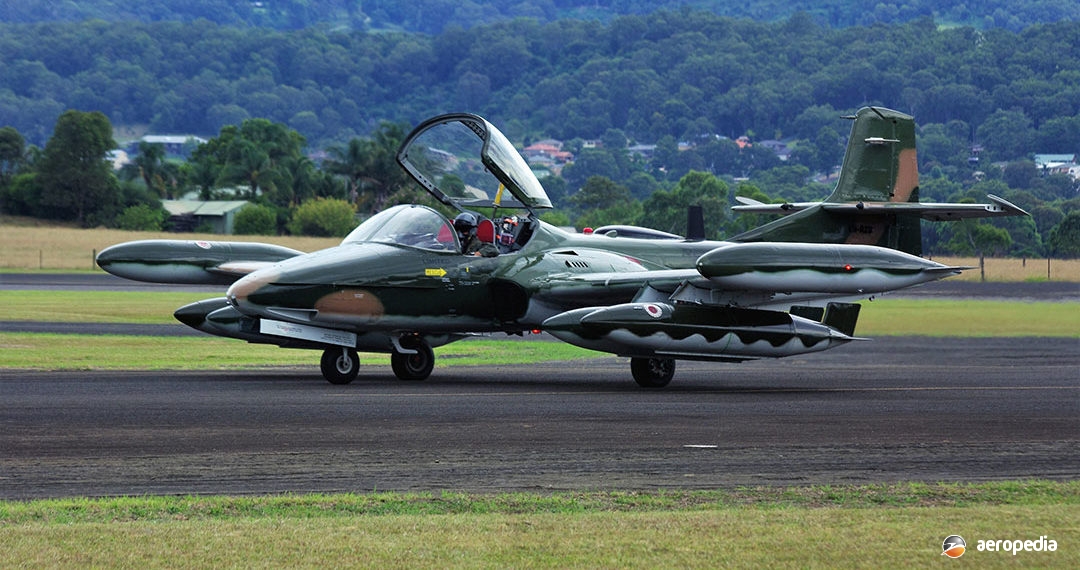Photograph:
Cessna A-37B Dragonfly VH-AZD (c/n 43158) at Albion Park, NSW in February 2011 (David C Eyre)
Country of origin:
United States of America
Description:
Two-seat light strike military aircraft
Power Plant:
Two 2,850 lbst General Electric J85-GE-17A turbojets
Specifications:
- Wingspan: 10.93 m (35 ft 10½ in)
- Length: 8.92 m (29 ft 3 in)
- Height: 2.7 m (8 ft 10½ in)
- Wing area: 17.09 m² (183.95 sq ft)
- Max speed at sea level: 746 km/h (464 mph)
- Max speed at 4,572 m (15,000 ft): 769 km/h (478 mph)
- Initial rate of climb (clean): 2,621 m/min (8,600 ft/min)
- Time to 9,144 m (30,000 ft): 16.8 mins
- Service ceiling: 9,785 m (32,100 ft)
- Stalling speed: 138 km/h (86 mph)
- Mission radius with max ordinance load: 248 km (154 miles)
- Empty weight: 2,670 kg (5,873 lb)
- Loaded weight: 804 kg (15,000 lb)
History:
In 1953 Cessna with its Model 318 won a design competition for production of a two-seat side-by-side jet trainer for the USAF powered by two Continental J-69 turbojet engines, these being Americanised versions of the French Turbomeca Marbore. Two prototypes were built with the designation XT-37, the first flying on 12 October 1954. Subsequently 534 examples were built as the T-37A. Later the T-37B was developed with the more powerful 1,025 lbst engines, and all surviving T-37As were converted to this configuration. Final trainer version was the T-37C with provision for armament and wingtip fuel tanks. A total of 1,268 T-37s was built for the USAF, and examples were supplied to Brazil, Chile, Colombia, Greece, Kampuchea, Pakistan, Thailand, Turkey and West Germany.
In 1962 two T-37s were evaluated by the USAF Special Air Warfare Centre to consider their suitability for the counter insurgency role. After an initial test period, the airframes were modified to accept two 2,400 lbst General Electric J-85-GE-5 turbojets and they became known as the YAT-37D, with a maximum take-off weight of 6,350 kg (14,000 lb).
The need for a light ground attack aircraft in the war in Vietnam led to a contract in 1966 to convert 39 T-37B trainers to light strike configuration, the first being delivered on 2 May 1967. Later that year a squadron of 25 aircraft, known as the A-37A Dragonfly, operated in South Vietnam to evaluate their performance. In the four months they operated they flew more than 5,000 sorties from Bien Hoa, and made 3,000 strikes without loss to enemy action.
In September 1967 Cessna flew a purpose-designed light strike aircraft based on the T-37, and this became the A-37B. The airframe was stressed for 6G and fuel capacity increased to 1,920 litres (422.3 Imp gals). Four auxiliary tanks with a combined capacity of 1,516 litres (333.4 Imp gals) could be carried. General Electric J-85-GE-17A engines were fitted. Armament consisted of a 7.62 mm (o.30 in) minigun and eight underwing hard-points for up to 2,268 kg (5,000 lb) of bombs and rockets. Provision was made for air-to-air refuelling. Later, underwing pods for 20 mm GPU-2/A cannon could be fitted. A total of 577 A-37Bs was built.
Early in 1990 a batch of five Cessna A-37Bs arrived in Sydney, NSW from South Vietnam, having been obtained by a warbird enthusiast, and work commenced on the restoration of these to airworthiness. The first completed was VH-DLO (c/n 43156 –ex-68-10805)) in April 1992 which has since become part of the collection of warbirds at Temora, NSW. Nine examples in all have been imported to this region. The second completed became VH-IVI (c/n 43284), an A-37B-CE, but which, shortly after restoration, was exported to the United States in 1996 and became N437B. Further aircraft have been restored, including VH-XVA (ex 68-10779) also with the Temora Aviation Museum.
Others registered have included: VH-BPM (c/n 43158 -ex 68-10807) at Toowoomba, QLD; VH-CPD (ex 71-0793) based at Scone, NSW; and VH-NUI (ex 67-14810) based also at Toowoomba.
One which became ZK-JTL ( c/n 43392 – ex 71-0854) has been airworthy with Jet Trainers Ltd of Auckland, NZ, being registered in late 1991 but did not make its first post restoration flight until 1994. Other Cessna A-37s have arrived in New Zealand and these have included 68-7945 and Vietnam Air Force serial VNAF 296 (c/n 43311 – ex 70-1296) at Ardmore.

